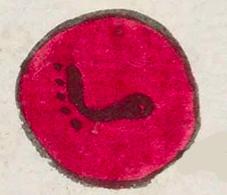Tlauhpan (Mdz12r)
This compound glyph for the place name Tlauhpan includes a round circle filled with the color red (tlatlauhqui) and a black (left) footprint, which can represent the verb pano, to cross over, or just imply being "on" something, standing for the locative suffix (-pan). The footprint is shown in a bird's eye view, and it is heading toward the viewer's left.
Stephanie Wood
Tlauhpan is Tlapan (or, today, Tlapa). Another way of saying red is tlapalli. But Gordon Whittaker (Deciphering Aztec Hieroglyphs, 2021, 95), sees the stem as "tlauh." (See his transliteration, below.) See below, too, for another example of a footprint being used to say "-pan."
Footprint glyphs have a wide range of translations. In this collection, so far, we can attest to yauh, xo, pano, -pan, paina, temo, nemi, quetza, otli, iyaquic hualiloti, huallauh, tetepotztoca, totoco, -tihui, and the vowel "o." Other research (Herrera et al, 2005, 64) points to additional terms, including: choloa, tlaloa, totoyoa, eco, aci, quiza, maxalihui, centlacxitl, and xocpalli.
Stephanie Wood
tlapan. puo
Tlauhpan, pueblo (Tlapa, Guerrero, today)
Stephanie Wood
c. 1541, or by 1553 at the latest
Stephanie Wood
colors, rojo, colores, nombres de lugares

tlatlauh(qui), red, https://nahuatl.wired-humanities.org/content/tlatlauhqui
tlapal(li), red, https://nahuatl.wired-humanities.org/content/tlapalli
-pan (locative suffix), https://nahuatl.wired-humanities.org/content/pan
pano, to cross over, https://nahuatl.wired-humanities.org/content/pano
"On the Red" (Whittaker, 2021, 95)
TLAUH•pan2
Codex Mendoza, folio 12 recto, https://digital.bodleian.ox.ac.uk/objects/2fea788e-2aa2-4f08-b6d9-648c00..., image 34 of 188.
The Bodleian Libraries, University of Oxford, hold the original manuscript, the MS. Arch. Selden. A. 1. This image is published here under the UK Creative Commons, “Attribution-NonCommercial-ShareAlike 3.0 License” (CC-BY-NC-SA 3.0).



